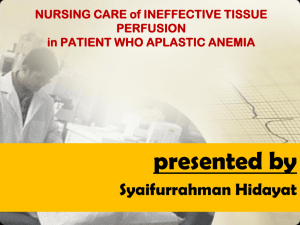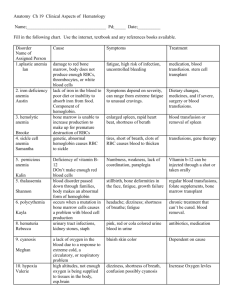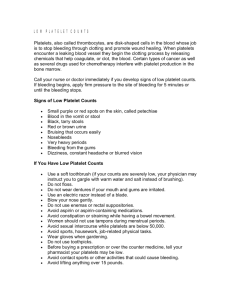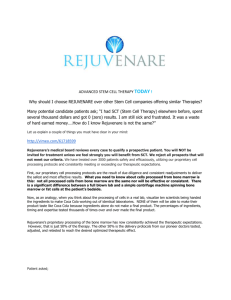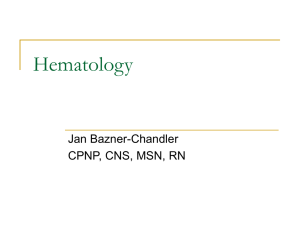Assessment and management of patients with hematologic disorder blood reticuloendothelial
advertisement
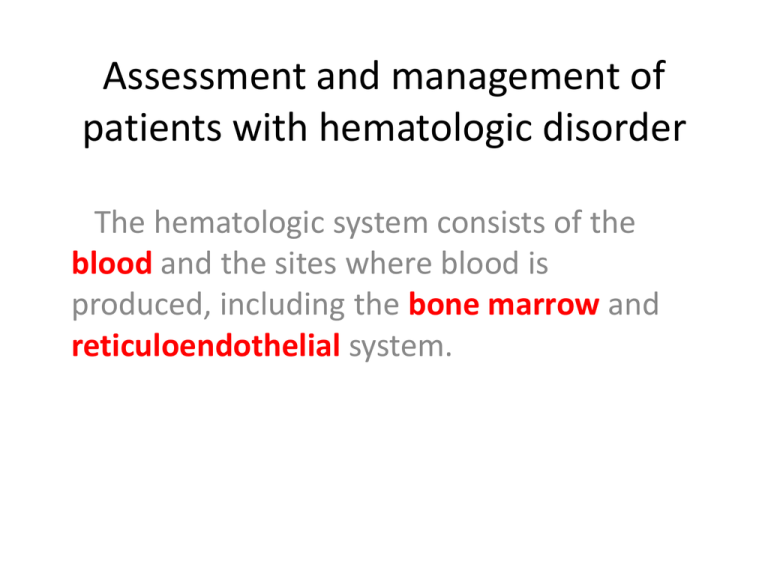
Assessment and management of patients with hematologic disorder The hematologic system consists of the blood and the sites where blood is produced, including the bone marrow and reticuloendothelial system. Blood The cellular component of blood consists of 3 primary cell types: Erthrocytes (RBCs) Leukocytes (WBCs) Thrombocytes (platelets) Blood Component of blood normally make up: 40%-45% of the blood volume. The adult bone marrow produces about 175 billion erythrocytes each day 70 billion neutrophils and 175 billion platelets each day Blood Blood make up approximately 7% - 10% of the normal body weight and amount to 5 – 6 L. of volume. Blood Blood circulating through the vascular system and serving as a link between body organs, blood carries O2 absorbed from the lung and nutrients absorbed from gastrointestinal tract to the body cells for cellular metabolism. Blood Blood carries hormones, antibodies, and other substances to their sites of action or use. Blood carries waste products produced by cellular metabolism to the lungs, skin, liver, and kidneys. Bone Marrow Is the site of hematopoiesis, or the blood cells formation. In adults, blood cells formation is usually limited to the pelvic, ribs, vertebrae, and sternum. Bone Marrow Marrow is one of the largest organs of the body, marking up (4% - 5%) of total body weight. Bone Marrow The marrow is highly vascular. Within it are primitive cells called stem cells. The stem cells have the ability to self-replicate, thereby ensuring a continuous supply of stem cells throughout the life cycle. Stem cells When stimulated to do so, stem cells can begin a process of differentiation into either: Myeloid or Lymphoid stem cells Stem Cells These stem cells are committed to produce specific types of blood cells. Lymphoid stem cells produce either T or B lymphocytes. Stem Cells Myeloid stem cells differentiate into 3 broad cell types: Erthrocytes Leukocytes and platelets Reticuloendothelial system (RES) The reticuloendothelial system (RES) Is an essential component of the immune system, comprised of phagocytic cells located in different organs of the human body. phagocytic cells Phagocytic cells are derived from the bone marrow stem cells and become monocytes, which circulate in the blood. Most of these monocytes migrate to different tissues inside the body. Phagocytic cells Phagocytic cells capable of engulfing substances, such as bacteria and viruses, rendering them incapable of causing harm to the body. They also ingest abnormal cells and old cells, thus clearing the body of their harmful presence. Assessment and Diagnostic Evaluation Hematologic Studies: CBC to identifies the total number of blood cells (leukocytes, erythrocytes, and platelets). As well as the Hb, hematocrite( % of blood volume consisting of erthrocytes), and RBC Assessment and Diagnostic Evaluation Bone Marrow Aspiration and Biopsy: These tests are also used to document infection or tumor within the marrow. Bone marrow is usually aspirated from the iliac crest and occasionally from the sternum. Leukemia is a neoplastic proliferation of one particular cell type (granulocytes, monocytes, lymphocytes, or infrequently erythrocytes or megakaryocytes). Classification of Leukemia Leukemia are commonly classified according to the stem cell line involved, either : lymphoid L. Acute and chronic Myeloid L. Acute and chronic Nursing Process The patient with acute Leukemia: Assessment : Weakness and fatigue the resulting complication of anemia and infection. A dry cough, mild dyspnea, and diminished breath sound may indicted a pulmonary infection . The absence of neutrophils delays the inflammatory response against the pulmonary Infection. Bleeding tendancy resulting from platelet low. . Nursing Diagnosis Risk for infection and bleeding Risk for impaired skin integrity Impaired gas exchange Impaired mucous membrane Imbalance nutrition Acute pain and discomfort Hyperthermia Nursing Diagnosis Hyperthermia Fatigue and activity intolerance Impaired physical mobility Risk for excessive fluid volume Diarrhea due to altered GI flora due to broad-spectrum antibiotics. Risk for deficit fluid volume Self-care deficit Anxiety Disturbed body image Deficient knowledge Spiritual distress Nursing Intervention Prevent infection and bleeding Managing mucositis Improving nutritional intake Easing pain and discomfort Decreasing fatigue and discomfort Maintaining fluid and electrolyte balance Improving self care Managing anxiety and grief Encouraging spiritual well-being Promoting home and community-based care Lymphoma Are neoplasm of the cells of lymphoid origin. Started in lymph nodes but can involve lymphoid tissue in the: spleen GI tract liver and bone marrow Classification 1. Hodgkin L. 2. Non Hodgkin L. Hodgkin L. Is relatively rare malignancy Has an impressive cure rate Common in men than women Has two peak incidence: the early 20 and after 50 years of age. Seen more commonly in patient receiving immunosuppressive drugs. Pathophysiology unicentric in origin. initiates in a single node. spreads by contiguous extension along the lymphatic system. Causes The cause is unknown but a viral etiology is suspected. Clinical Manifestation Painless enlargement of one or more lymph nodes on one side of the neck. Firm not hard . Most common sites for LAP are the cervical supraclavicular Midiastinal nodes and iliac and inguinal nodes or spleen. May be seen on chest x-ray. Clinical Manifestation The mass is large enough to compress the trachea. And cause dyspnea. pruritus is common and the cause is unknown. All organs are vulnerable to invasion by tumor. Clinical Manifestation The symptoms result from compression of organs by the tumor, such as: cough, pulmory effusion, jaundice, abdominal pain( from splenomegaly or retroperitoneal adenopathy). Bone pain ( from skeletal involvement) Clinical Manifestation Herpes zoster infection are common. Fever A mild anemia is the most common hematologic finding. Assessment and Diagnostic Findings Excisional lymph node biopsy. Systematic evaluation of the lymph node chains. Chest x-ray and a CT scan of the chest. Abdomen and the pelvic to identify the extent of lymphadenopathy within these regions. Assessment and Diagnostic Findings CBC Liver and renal function test A bone marrow biopsy is performed Bone scan Medical Management A short course (2-4)month of chemotherapy Followed by radiation therapy. Combination chemotherapy with doxorubicin (A driamycin), bleomycin (Blenoxane) . Nursing Management Hodgkin L. is often curable. The nurse encourage pts. To reduce other factors that increase the risk of developing second cancer. Such as use to tobacco and alcohol and exposure to environmental carcinogens and excessive sunlight. Nursing Management Screening for late effects of treatment is necessary. Provide education about relevant self-care strategies and diseases management. NHLs Are heterogeneous group of cancer that originate from the neoplastic grow of lymphoid tissue. Neoplastic cells a rise from a single clone of lymphocytes. NHLs involve malignant B lymphocyte , only 5% involve T lymphocytes. The lymphoid tissues involved are largely infiltrated with malignant cells. Spreads cells occurs unpredictably NHLs 5th most common type of cancer diagnosed in the USA. The incidence increases each decade of life. The median age at diagnosis is 67 yrs. Causes No common etiological factor has been identified. Increase in people with immunodeficiencies or autoimmune disorders Clinical Manifestations LAP is most common 66% Fever Night sweats Amass in the mediastinum can cause respiratory distress. Mass can compromise the ureters, leading to renal dysfunction , and splenomegaly, can cause abdominal pain, anorexia, and weight loss. Assessment and Diagnostic Findings CT scan of the chest Bone marrow biopsy C.S.F Medical Management Chemotherapy ( cytoxan, vincristine and prednisolon). Nursing Management The most commonly used treatment methods are chemotherapy and radiation therapy. Chemotherapy causes systemic side effects( mylosuppression, nausea, hair loss, risk for infection). Nursing Management Radiation therapy causes specific side effects that are limited to the area being irradiated. The risk of infection is significant. Because the defect of immune response that result from the disease it self. Assess for airway obstruction, if the mass is near the bronchia, or trachea. Bleeding Tendency Failure of normal hemostatic mechanisms. When the sources is platelet or coagulation factor abnormalities, the site of bleeding can be anywhere in body. Clinical Manifestations Petechiae, these are seen on the skin and mucous membrances but also occur throughout the body. Bleeding from platelet disorders can be sever. Bleeding occurs deeper within the body (subcutaneous or IM hematoma, hemorrhage into joint spaces). Clinical Manifestations Sever bleeding may start several hours after a tooth extraction. Medical Management Transfusion of blood products are indicated. A patient schedule for an invasive procedures, including a dental extraction, may need a transfusion prior to the procedure to minimize the risk of excessive bleeding. Nursing Management Observe carefully and frequent for bleeding. Avoid activities that increases the risk of bleeding. Hospitalized patients are monitored for bleeding by testing all drainage and excreta ( feces, urine, emesis, and gastric drainage) for occult blood. Outpatients are often given fecal occult blood screening cards to detect occult blood in stool. Idiopathic Thrombocytopenic purpura Is a disease that affect people of all ages, but it more common in children and young women . There are two forms of IPT acute and chronic Pathophysiology Antiplatelet auto antibodies that bind to the patients that bind to the platelets are found in the blood. When the platelets are bound by the antibodies. The RES or tissue macrophage system ingests the platelets, destroyed them. Pathophysiology The body attempt s to compensate for this destruction by increasing platelet production within the marrow. Clinical Manifestations Many patient have no symptoms. And the low platelet count ( often less than 20,000/mm less than 5000/mm is not uncommon Clinical Manifestations Bruising Heavy menses Petechiae on the extremities or trunk Dry purpura tend to have fewer complications from bleeding than those with bleeding from mucosal surfaces, such as the GI tract ( including mouth ) and pulmonary system ( hemoptysis) Assessment and Diagnostic Findings Decrease in platelets (less than 20,000/mm) is commonly. Some patients are found to be infected with H. pylori and eradicating the infection may improve platelet counts. Assessment and Diagnostic Findings It is unclear why H. pylori and IPT are correlated . It is thought that H. pylori may cause an autoimmune reaction. Medical Management The corticosteroid (Prednisolon) is typically used . Dexamethason (Decadron) is also effective. The immunosuppressive (Azathoprine) Imuran. Chemotherapy agent Vincristine. Nursing Management Assessment of the patients lifestyle to determine the risk of bleeding from activity. A carful medication history is also obtained, including use of over-thecounter medication, herbs, and nutritional supplements. The nurse must be alter for sulfa-containing medication and the others that alter platelet function( aspirin) . Nursing Management Assess any history of recent viral illness and reports headache or visual disturbance. Patients who are admitted to the hospital with wet purpura and low platelet counts should have a neurological assessment Nursing Management All injection or rectal medication should be avoided. Rectal temperature measurement should not be performed, because they can stimulate bleeding. Nursing Management Patient teaching about signs of bleeding (e.g. Petechia, ecchymoses. The patient should avoid constipation and flossing of the teeth. Electrical razors should be used for shaving and soft toothbrushes. Patient who receiving corticosteroid long time are at risk for complications.

